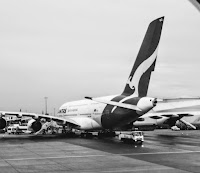
31 Jul Five Good Resources for Learning About Airplanes and Airlines
We’re planning a little trip this fall to visit some family that we haven’t seen since before the start of the pandemic. When we told our daughters that we’re going to fly they got very excited about it. We’ve now been answering questions about flying seemingly nonstop for a few days. Those conversations prompted me to compile this list of resources for teaching and learning about the science of flight.
Turbulence: One of the Great Unsolved Mysteries of Physics is a TED-Ed lesson that explains what turbulence is and the forces that create it. The lesson explains that even though we typically associate turbulence with flying in airplanes, turbulence exists in many other places including oceans.
Here’s some archival footage of Yeager’s flight in the Bell X-1.
We’re planning a little trip this fall to visit some family that we haven’t seen since before the start of the pandemic. When we told our daughters that we’re going to fly they got very excited about it. We’ve now been answering questions about flying seemingly nonstop for a few days. Those conversations prompted me to compile this list of resources for teaching and learning about the science of flight. Turbulence: One of the Great Unsolved Mysteries of Physics is a TED-Ed lesson that explains what turbulence is and the forces that create it. The lesson explains that even though we typically associate turbulence with flying in airplanes, turbulence exists in many other places including oceans.The Wright Brothers – The Invention of the Aerial Age offers timelines for teaching about the developments made by the Wright Brothers. Dig into the Interactive Experiments section of the timeline and you’ll find Engineering the Wright Way. Engineering the Wright Way offers interactive simulations in which students learn about wing design by joining the Wright Brothers for test flights in Kitty Hawk, North Carolina.How Things Fly hosted by the Smithsonian features an interactive module in which students design their own airplanes. The activity starts with a simple and slow airplane that students have to modify until it reaches a target speed and altitude. As students modify the wings, fuselage, and engines of their airplanes they are given instant feedback on the effects of those modifications. In some cases the feedback includes the airplane crashing and the students having to start over again.TED-Ed offers a lesson about breaking the sound barrier. The lesson is called The Sonic Boom Problem and it explains how a sonic boom is created and how math is used to predict the path of a sonic boom in the atmosphere. Here’s some archival footage of Yeager’s flight in the Bell X-1. If you have ever wondered why airlines sell more tickets than they have seats on an airplane, the TED-Ed lesson Why Do Airlines Sell Too Many Tickets? is for you. In Why Do Airlines Sell Too Many Tickets? you can learn about the mathematics that airlines use to maximize the revenue that they can generate from each flight. That math includes calculating the probability that everyone who holds a ticket for a flight will actually show up for the flight. The way that probability is calculated is explained in the video. Finally, the lesson asks students to consider the ethics of overbooking flights. Watch the video below or go here to see the entire lesson.Are you a tech coach or media specialist looking for some new ideas to share with your colleagues? If so, 50 Tech Tuesday Tips is an eBook you need. You can get it right here. air travel, airplanes, Educational Videos, Free Technology For Teachers, Physics, Science, smithsonian, STEM, TED-Ed LessonRead More
air travel, airplanes, Educational Videos, Free Technology For Teachers, Physics, Science, smithsonian, STEM, TED-Ed LessonRead More


Sorry, the comment form is closed at this time.